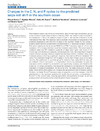Please use this identifier to cite or link to this item:
http://hdl.handle.net/10553/75421
| Title: | Changes in the C, N, and P cycles by the predicted salps-krill shift in the southern ocean | Authors: | Alcaraz, Miquel Almeda García, Rodrigo Duarte, Carlos M. Horstkotte, Burkhard Lasternas, Sebastien AgustÃ, Susana |
UNESCO Clasification: | 251001 Oceanografía biológica | Keywords: | Southern Ocean Zooplankton Community shifts Metabolism Carbon cycling, et al |
Issue Date: | 2014 | Project: | ATOS - Atmospheric inputs of organic carbon and pollutants to the polar ocean: rates, significance and outlook (POL2006-00550/CTM) PERFIL (CTM 2006-12344-C01) |
Journal: | Frontiers in Marine Science | Abstract: | The metabolic carbon requirements and excretion rates of three major zooplankton groups in the Southern Ocean were studied in February 2009. The research was conducted in the framework of the ATOS research project as part of the Spanish contribution to the International Polar Year. The objective was to ascertain the possible consequences of the predicted zooplankton shift from krill to salps in the Southern Ocean for the cycling of biogenic carbon and the concentration and stoichiometry of dissolved inorganic nutrients. The carbon respiratory demands and NH4-N and PO4-P excretion rates of <5 mm size copepods, krill and salps were estimated by incubation experiments. The carbon-specific metabolic rates and N:P metabolic quotients of salps were higher than those of krill (furcilia spp. and adults) and copepods, and as expected there was a significant negative relation between average individual zooplankton biomass and their metabolic rates, each metabolic process showing a particular response that lead to different metabolic N:P ratios. The predicted change from krill to salps in the Southern Ocean would encompass not only the substitution of a pivotal group for Antarctic food webs (krill) by one with an indifferent trophic role (salps). In a zooplankton community dominated by salps the respiratory carbon demand by zooplankton will significantly increase, and therefore the proportion of primary production that should be allocated to compensate for the global respiratory C-losses of zooplankton. At the same time, the higher production by salps of larger, faster sinking fecal pellets will increase the sequestration rate of biogenic carbon. Similarly, the higher N and P excretion rates of zooplankton and the changes in the N:P stoichiometry of the metabolic products will modify the concentration and proportion of N and P in the nutrient pool, inducing quantitative and qualitative changes on primary producers that will translate to the whole Southern Ocean ecosystem. | URI: | http://hdl.handle.net/10553/75421 | ISSN: | 2296-7745 | DOI: | 10.3389/fmars.2014.00045 | Source: | Frontiers in marine science [ISSN 2296-7745], v.1, 45 (September 2014) |
| Appears in Collections: | Artículos |
WEB OF SCIENCETM
Citations
24
checked on Mar 30, 2025
Page view(s)
108
checked on May 11, 2024
Download(s)
99
checked on May 11, 2024
Google ScholarTM
Check
Altmetric
Share
Export metadata
Items in accedaCRIS are protected by copyright, with all rights reserved, unless otherwise indicated.
